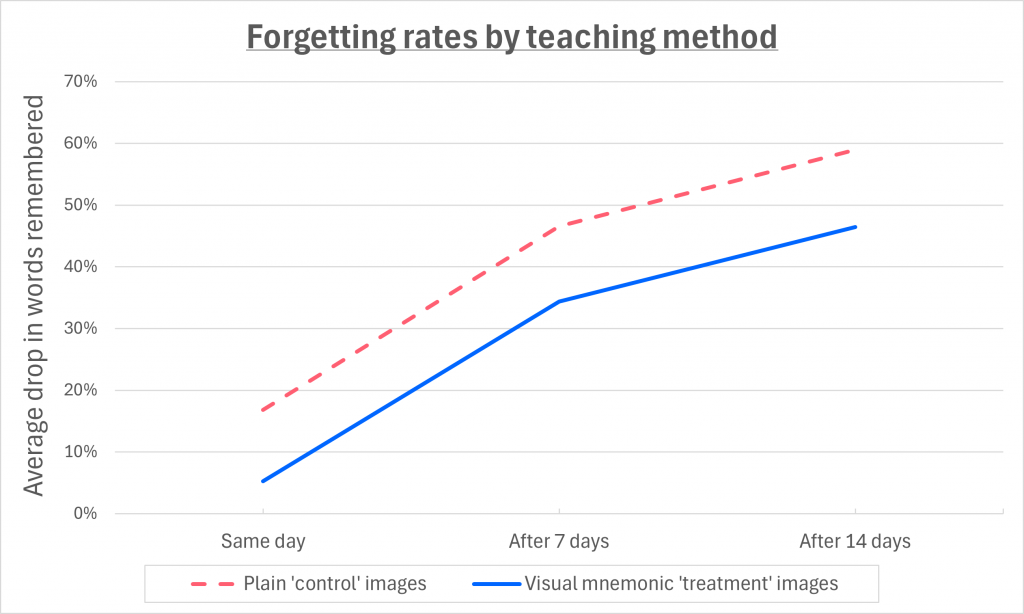What are visual mnemonics?
What’s a technique that’s been used for thousands of years and allows people to learn large amounts of information quickly? Visual Mnemonics! These memory aids use powerful, imaginative imagery to anchor information in your mind. They are the secret weapon of professional memory athletes to learn the order of a shuffled deck of cards in less than a minute, and what the legendary Akira Haraguchi used to memorize 100,000 digits of pi.
Yet, despite tales of extraordinary feasts of memory over the last 2500 years, there is little formal evidence that visual mnemonics work. At Bridgely we wanted rigorous evidence: Do they really work? And if so, how much more effective are they than traditional learning methods?
How we set up our experiment
Following the gold standard of scientific research – a randomized controlled trial (RCT) –, we conducted an experiment to answer our questions. We recruited 100 participants from our network and chose a language they were unlikely to know: Swahili!
We chose 10 common words (chair, church, knife, market, neck, paper, pig, table, trees, water,) and created two images of each word: one ‘control’ image with only the object being learned, and a ‘treatment’ image using a visual mnemonic. See an example below:

English: Pig
Swahili: Nguruwe

English: Pig
Mnemonic: A pig that’s a guru
Swahili: Nguruwe

English: Water
Swahili: Maji

English: Water
Mnemonic: Water that’s magic
Swahili: Maji
So, who sees the control images and who sees the treatment images?
Instead of assigning participants to either control or treatment groups entirely, we randomized at the word level to maximize statistical power. This means that each participant saw a mix of both control and treatment images, rather than just one type.
The randomization strategy had the following features:
- Each word had a 50% probability of being a treatment (mnemonic) image and 50% probability of being control image.
- Each participant learned exactly five words with mnemonics (treatment) and five words with control images.
- The order of words was fixed, and the randomization took place by pairs: if the first word in a pair was assigned a mnemonic image, the second had a control image. This process was repeated independently for each subsequent pair. This ensured an even distribution of treatment and control words, preventing long sequences of only one type of image.
For each word in the experiment, participants went through four learning rounds, progressively more difficult. In the fifth and final round, they were asked to directly translate the English word into Swahili from memory, with no images to help them. We analyzed the fraction of participants that spelled the word exactly or almost correctly.
We also had a second layer of randomization to add a follow-up stage a few days after the initial session. The follow-up test was scheduled 7 days later for 50% of participants and 14 days later for the other half.
The results: Do visual mnemonics work?
The overwhelmingly clear result was…. visual mnemonics work! We found the improvements in recall for the treatment group were statistically significant (p<0.001):
| Time frame | Relative change in performance* (treatment vs. control) | Relative odds of correct recall** |
| Same day | +15% | x3.7 |
| After 7 days | +33% | x1.9 |
| After 14 days | +36% | x1.7 |
** This value represents how many words were correctly recalled for every incorrectly recalled word when taught with visual mnemonics, relative to the same ratio for words taught using plain (control) images.
To put this in context, when learning words using visual mnemonics compared to plain images, you can correctly recall nearly 4 times more words for every mistake you make right after the learning session, and nearly 2 times more after a couple of weeks. For certain subgroups, this performance measure was up to 6 times better for words learnt using visual mnemonics, dramatically increasing learning speeds.

By applying the compounding difference in forgetting curves between the two methods, we calculated that it takes half the time to completely learn a set of words when using visual mnemonic images compared to traditional plain images.
Implications
Bridgely’s experiment provides some of the first rigorous evidence that visual mnemonics work, supporting the existing rich memory literature, and is an example of our commitment to evidence-based methods and transparency. But what does all this mean for everyday learners?
- Speed: With slower forgetting rates that compound over time, those using visual mnemonics can learn vocabulary rapidly and reach intermediate level quicker.
- Money: Books, apps, language schools, private tutors and studying abroad all cost money. By using visual mnemonics to learn vocabulary quickly, you can target your money on the parts of language learning you find trickiest.
- Time: If it takes 500+ hours to reach fluency in a language, we estimate using visual mnemonics for vocabulary can save 150 hours within a year; that’s nearly 4 working weeks! What would you do with all that free time?

Leave a Reply